c824b82edab6d11c97fc19eca7f987ed.ppt
- Количество слайдов: 60
 Fundamentals of GIS Lecture 9: More Input Methods and Data Quality and Documentation By Austin Troy University of Vermont NR 343 Materials by Austin Troy © 2008
Fundamentals of GIS Lecture 9: More Input Methods and Data Quality and Documentation By Austin Troy University of Vermont NR 343 Materials by Austin Troy © 2008
 Fundamentals of GIS ------Using GIS-- Part 1: • Data input methods: Digitizing and Geocoding Materials by Austin Troy © 2008
Fundamentals of GIS ------Using GIS-- Part 1: • Data input methods: Digitizing and Geocoding Materials by Austin Troy © 2008
 Fundamentals of GIS 1. Geocoding Materials by Austin Troy © 2008
Fundamentals of GIS 1. Geocoding Materials by Austin Troy © 2008
 Fundamentals of GIS What is Geocoding? • Convert lists/spreadsheets to geographical features • Needs a mechanism to calculate the geographic coordinate for the address • Address matching: uses street address database, created from a streets layer. Materials by Austin Troy © 2008
Fundamentals of GIS What is Geocoding? • Convert lists/spreadsheets to geographical features • Needs a mechanism to calculate the geographic coordinate for the address • Address matching: uses street address database, created from a streets layer. Materials by Austin Troy © 2008
 Fundamentals of GIS Address Matching Geocoding • Two inputs: – 1) a DBF or text table with the address records to be geocoded and – 2)a geographic reference layer, like streets • Output: a point file, where each point represents an address record Materials by Austin Troy © 2008
Fundamentals of GIS Address Matching Geocoding • Two inputs: – 1) a DBF or text table with the address records to be geocoded and – 2)a geographic reference layer, like streets • Output: a point file, where each point represents an address record Materials by Austin Troy © 2008
 Fundamentals of GIS How are addresses matched? • Common method: matching address to street ranges. • Urban areas: usually each street segment (arc) corresponds to a block. • Each segment has attributes for the left from and to and right from and to addresses. • Computer knows topological left and right for each street segment • Step 1: Computer looks for segment with correct name and address range • Step 2: Computer interpolates the position of the address point on segment Materials by Austin Troy © 2008
Fundamentals of GIS How are addresses matched? • Common method: matching address to street ranges. • Urban areas: usually each street segment (arc) corresponds to a block. • Each segment has attributes for the left from and to and right from and to addresses. • Computer knows topological left and right for each street segment • Step 1: Computer looks for segment with correct name and address range • Step 2: Computer interpolates the position of the address point on segment Materials by Austin Troy © 2008
 Fundamentals of GIS Geocoding example: 1060 Main Street It looks for Main street, then for the 1000 -1100 block L-F-ADDR 1000 1001 L-T-ADDR Main St direction R-F-ADDR • It places it on even (upper) side of street • Position of 1060 is interpolated 1100 1101 R-T-ADDR 1060 Main St Materials by Austin Troy © 2008
Fundamentals of GIS Geocoding example: 1060 Main Street It looks for Main street, then for the 1000 -1100 block L-F-ADDR 1000 1001 L-T-ADDR Main St direction R-F-ADDR • It places it on even (upper) side of street • Position of 1060 is interpolated 1100 1101 R-T-ADDR 1060 Main St Materials by Austin Troy © 2008
 Fundamentals of GIS Address Matching in Arc. GIS • First create a address locator in Arc Catalog • Defines reference layer • Also where you specify information about your reference layer that Arc. GIS might not know, allowing for more efficient geocoding • Many “styles” to choose from in for address locators Materials by Austin Troy © 2008
Fundamentals of GIS Address Matching in Arc. GIS • First create a address locator in Arc Catalog • Defines reference layer • Also where you specify information about your reference layer that Arc. GIS might not know, allowing for more efficient geocoding • Many “styles” to choose from in for address locators Materials by Austin Troy © 2008
 Fundamentals of GIS Geocoding Service • Geocoding styles are necessary because – Reference layers come in many forms and formats. For instance, a reference layer may have the from right address attribute as fr_rt_add or add_rt_frm) – There are other types of geocoding, besides address geocoding, like geocoding points to the center of zip codes, and there are other types of address geocoding besides street address geocoding, like using a property parcel layer as reference. Materials by Austin Troy © 2008
Fundamentals of GIS Geocoding Service • Geocoding styles are necessary because – Reference layers come in many forms and formats. For instance, a reference layer may have the from right address attribute as fr_rt_add or add_rt_frm) – There are other types of geocoding, besides address geocoding, like geocoding points to the center of zip codes, and there are other types of address geocoding besides street address geocoding, like using a property parcel layer as reference. Materials by Austin Troy © 2008
 Fundamentals of GIS Geocoding in Arc GIS • In geocoding style interface: choose your reference file and then specify which attributes in the reference layer correspond with the inputs that Arc. GIS needs to do geocoding. • It also asks for some information about what to expect in your geocoding table (what the required attribute headings are called) and how sensitive to be to things like spelling differences Materials by Austin Troy © 2008
Fundamentals of GIS Geocoding in Arc GIS • In geocoding style interface: choose your reference file and then specify which attributes in the reference layer correspond with the inputs that Arc. GIS needs to do geocoding. • It also asks for some information about what to expect in your geocoding table (what the required attribute headings are called) and how sensitive to be to things like spelling differences Materials by Austin Troy © 2008
 Fundamentals of GIS Specify reference file Specify address range attributes Specify zone Materials by Austin Troy © 2008 Specify rules for address list
Fundamentals of GIS Specify reference file Specify address range attributes Specify zone Materials by Austin Troy © 2008 Specify rules for address list
 Fundamentals of GIS Geocoding in Arc GIS • Now, in Arc Map we go to Tools>>Geocode Addresses and we add the geocoding service we want to use • This brings up the geocoding interface where we specify which field holds the address and which holds the zone • Also specify an output shapefile or geodatabase and geocoding sensitivity Materials by Austin Troy © 2008
Fundamentals of GIS Geocoding in Arc GIS • Now, in Arc Map we go to Tools>>Geocode Addresses and we add the geocoding service we want to use • This brings up the geocoding interface where we specify which field holds the address and which holds the zone • Also specify an output shapefile or geodatabase and geocoding sensitivity Materials by Austin Troy © 2008
 Fundamentals of GIS Geocoding in Arc GIS • After geocoding, it tells me how many were successfully matched and how many were either totally unmatchable or potentially matchable • We can interactively match the potential ones if we want Materials by Austin Troy © 2008
Fundamentals of GIS Geocoding in Arc GIS • After geocoding, it tells me how many were successfully matched and how many were either totally unmatchable or potentially matchable • We can interactively match the potential ones if we want Materials by Austin Troy © 2008
 Fundamentals of GIS Geocoding and Error • Your Geocoding result is only as good as your reference data. • If your streets layer is accurate only to 200 meters of accuracy, so will your geocoded points be • If your streets are consistently 100 meters to the north, then your points will be the same too • Some roads layers may have better attributes than other too. Materials by Austin Troy © 2008
Fundamentals of GIS Geocoding and Error • Your Geocoding result is only as good as your reference data. • If your streets layer is accurate only to 200 meters of accuracy, so will your geocoded points be • If your streets are consistently 100 meters to the north, then your points will be the same too • Some roads layers may have better attributes than other too. Materials by Austin Troy © 2008
 Fundamentals of GIS Geocoding and Error • Here’s an example where the same address list was geocoded with two different street layers. • Note here how the same house is 100 m off between the two geocoding attempts 100 m Materials by Austin Troy © 2008
Fundamentals of GIS Geocoding and Error • Here’s an example where the same address list was geocoded with two different street layers. • Note here how the same house is 100 m off between the two geocoding attempts 100 m Materials by Austin Troy © 2008
 Introduction to GIS Fundamentals of GIS Geocoding and Error • Here we see that many points were coded for Napa 1 that were not coded for Napa 2 possibly because Napa 1’s street reference layer is newer, and has more streets Materials by Austin Troy © 2008
Introduction to GIS Fundamentals of GIS Geocoding and Error • Here we see that many points were coded for Napa 1 that were not coded for Napa 2 possibly because Napa 1’s street reference layer is newer, and has more streets Materials by Austin Troy © 2008
 Fundamentals of GIS Geocoding and Error • This error is due to an attribute error in one of the layers which puts that address in the wrong street segment 100 m 300 m Materials by Austin Troy © 2008
Fundamentals of GIS Geocoding and Error • This error is due to an attribute error in one of the layers which puts that address in the wrong street segment 100 m 300 m Materials by Austin Troy © 2008
 Fundamentals of GIS Geocoding and Error Rural street segments are also more subject to more error because street segments longer, so relies more on interpolation An urban road segment: smaller, A rural area with a long road more segment: very imprecise Materials by Austin Troy © 2008 precise
Fundamentals of GIS Geocoding and Error Rural street segments are also more subject to more error because street segments longer, so relies more on interpolation An urban road segment: smaller, A rural area with a long road more segment: very imprecise Materials by Austin Troy © 2008 precise
 Fundamentals of GIS Geocoding in Action Mapping hazard zone properties in L. A. to see effects on property values Materials by Austin Troy © 2008
Fundamentals of GIS Geocoding in Action Mapping hazard zone properties in L. A. to see effects on property values Materials by Austin Troy © 2008
 Fundamentals of GIS XY Geocoding We can also create points from a table by their latitude and longitude Do this by clicking: • Then we specify the lat and long fields as well as the spatial reference system • Lat and Long should be in decimal degrees CA haz. waste sites Materials by Austin Troy © 2008
Fundamentals of GIS XY Geocoding We can also create points from a table by their latitude and longitude Do this by clicking: • Then we specify the lat and long fields as well as the spatial reference system • Lat and Long should be in decimal degrees CA haz. waste sites Materials by Austin Troy © 2008
 Introduction to GIS Fundamentals of GIS 2. Digitizing
Introduction to GIS Fundamentals of GIS 2. Digitizing
 Introduction to GIS Fundamentals of GIS Digitizing • This is generally the process of converting data from analog to digital with a device, such as a digitizing tablet or mouse, to create new vector features • User defines features by pointing and clicking. • Table digitizing involves use of a digitizing tablet or table • A digitizing table is a big table with an electronic mesh that can sense the position of a digitizing cursor • Transmits x and y coordinates of each mouse/cursor click to the computer and usually joins those with lines Materials by Austin Troy © 2008
Introduction to GIS Fundamentals of GIS Digitizing • This is generally the process of converting data from analog to digital with a device, such as a digitizing tablet or mouse, to create new vector features • User defines features by pointing and clicking. • Table digitizing involves use of a digitizing tablet or table • A digitizing table is a big table with an electronic mesh that can sense the position of a digitizing cursor • Transmits x and y coordinates of each mouse/cursor click to the computer and usually joins those with lines Materials by Austin Troy © 2008
 Introduction to GIS Fundamentals of GIS Digitizing • Notice how it is attached with tape Materials by Austin Troy © 2008 Source: http: //ndis. nrel. colostate. edu/ndis/riparian/Tablet. jpg • If it moves, the map will be inaccurate, because it’s recording position relative to the tablet, not the map
Introduction to GIS Fundamentals of GIS Digitizing • Notice how it is attached with tape Materials by Austin Troy © 2008 Source: http: //ndis. nrel. colostate. edu/ndis/riparian/Tablet. jpg • If it moves, the map will be inaccurate, because it’s recording position relative to the tablet, not the map
 Fundamentals of GIS Digitizing • Snapping: Arc will also snap closed any unsnapped lines or polygons and will crop dangling lines, based on user-defined tolerances • Snap tolerance: won’t snap together Snap tolerance: will snap together Dangling arc Snapped to other arc Materials by Austin Troy © 2008
Fundamentals of GIS Digitizing • Snapping: Arc will also snap closed any unsnapped lines or polygons and will crop dangling lines, based on user-defined tolerances • Snap tolerance: won’t snap together Snap tolerance: will snap together Dangling arc Snapped to other arc Materials by Austin Troy © 2008
 Fundamentals of GIS Digitizing • Digitizing on a tablet requires defining “control points” which allow the conversion of the digitized map to real world coordinates. • Usually, a corner point on the map of known geographic location is digitized first and its coordinates are assigned in some sort of header file • “Heads up” digitizing involves scanning a paper map to a digital file, or otherwise obtaining a digital raster map/ image and digitizing “on top” of it on computer Materials by Austin Troy © 2008
Fundamentals of GIS Digitizing • Digitizing on a tablet requires defining “control points” which allow the conversion of the digitized map to real world coordinates. • Usually, a corner point on the map of known geographic location is digitized first and its coordinates are assigned in some sort of header file • “Heads up” digitizing involves scanning a paper map to a digital file, or otherwise obtaining a digital raster map/ image and digitizing “on top” of it on computer Materials by Austin Troy © 2008
 Fundamentals of GIS Part 2 Spatial Data Quality Materials by Austin Troy © 2008
Fundamentals of GIS Part 2 Spatial Data Quality Materials by Austin Troy © 2008
 Fundamentals of GIS Data Quality • Accuracy+ Precision = Quality • Error= fn(accuracy, precision) • Cost vs. quality tradeoff Materials by Austin Troy © 2008
Fundamentals of GIS Data Quality • Accuracy+ Precision = Quality • Error= fn(accuracy, precision) • Cost vs. quality tradeoff Materials by Austin Troy © 2008
 Fundamentals of GIS Accuracy • “the degree to which information on a map or in a digital database matches true or accepted values. ” • • From Kenneth E. Foote and Donald J. Huebner http: //www. colorado. edu/geography/gcraft/notes/error_f. html Reflection of how close a measurement represent the actual quantity measured and of the number and severity of errors in a dataset or map. Materials by Austin Troy © 2008 Image source: http: //oopslist. com/
Fundamentals of GIS Accuracy • “the degree to which information on a map or in a digital database matches true or accepted values. ” • • From Kenneth E. Foote and Donald J. Huebner http: //www. colorado. edu/geography/gcraft/notes/error_f. html Reflection of how close a measurement represent the actual quantity measured and of the number and severity of errors in a dataset or map. Materials by Austin Troy © 2008 Image source: http: //oopslist. com/
 Fundamentals of GIS Precision • Intensity or level of preciseness, or exactitude in measurements. The more precise a measurement is, the smaller the unit which you intend to measure • Hence, a measurement down to a fraction of a cm is more precise than a measurement to a cm • However, data with a high level of precision can still be inaccurate—this is due to errors • Each application requires a different level of precision Materials by Austin Troy © 2008
Fundamentals of GIS Precision • Intensity or level of preciseness, or exactitude in measurements. The more precise a measurement is, the smaller the unit which you intend to measure • Hence, a measurement down to a fraction of a cm is more precise than a measurement to a cm • However, data with a high level of precision can still be inaccurate—this is due to errors • Each application requires a different level of precision Materials by Austin Troy © 2008
 Fundamentals of GIS Random and Systematic error • Error can be systematic or random • Systematic error can be rectified if discovered, because its source is understood Materials by Austin Troy © 2008 Image source: http: //oopslist. com/
Fundamentals of GIS Random and Systematic error • Error can be systematic or random • Systematic error can be rectified if discovered, because its source is understood Materials by Austin Troy © 2008 Image source: http: //oopslist. com/
 Fundamentals of GIS Random and Systematic error • Systematic errors affect accuracy, but are usually independent of precision; data can use highly precise methods but still be inaccurate due to systematic error Accurate and precise: no systematic , little random error inaccurate and precise: little random error but significant systematic error Accurate and imprecise: no systematic , but considerable random error inaccurate and imprecise: both types of error Materials by Austin Troy © 2008
Fundamentals of GIS Random and Systematic error • Systematic errors affect accuracy, but are usually independent of precision; data can use highly precise methods but still be inaccurate due to systematic error Accurate and precise: no systematic , little random error inaccurate and precise: little random error but significant systematic error Accurate and imprecise: no systematic , but considerable random error inaccurate and imprecise: both types of error Materials by Austin Troy © 2008
 Fundamentals of GIS Measurement of Accuracy Positional accuracy is often stated as a confidence interval: e. g. 104. 2 cm +/-. 01 means true value lies between 104. 21 and 104. 19 One of the key measurements of positional accuracy is root mean squared error (MSE); equals squared difference between observed and expected value for observation i divided by total number of observations, summed across each observation i This is just a standardized measure of error—how close the predicted measure is to observed Materials by Austin Troy © 2008
Fundamentals of GIS Measurement of Accuracy Positional accuracy is often stated as a confidence interval: e. g. 104. 2 cm +/-. 01 means true value lies between 104. 21 and 104. 19 One of the key measurements of positional accuracy is root mean squared error (MSE); equals squared difference between observed and expected value for observation i divided by total number of observations, summed across each observation i This is just a standardized measure of error—how close the predicted measure is to observed Materials by Austin Troy © 2008
 Fundamentals of GIS Positional Accuracy • Positional accuracy standards specify that acceptable positional error varies with scale • Data can have high level of precision but still be positionally inaccurate • Positional error is inversely related to precision and to amount of processing Materials by Austin Troy © 2008
Fundamentals of GIS Positional Accuracy • Positional accuracy standards specify that acceptable positional error varies with scale • Data can have high level of precision but still be positionally inaccurate • Positional error is inversely related to precision and to amount of processing Materials by Austin Troy © 2008
 Fundamentals of GIS Accuracy is tied to scale Materials by Austin Troy © 2008
Fundamentals of GIS Accuracy is tied to scale Materials by Austin Troy © 2008
 Fundamentals of GIS Positional Error Standards • Different agencies have different standards for positional error • Example: USGS horizontal positional requirements state that 90% of all points must be within 1/30 th of an inch for maps at a scale of 1: 20, 000 or larger, and 1/50 th of an inch for maps at scales smaller than 1: 20, 000 Materials by Austin Troy © 2008
Fundamentals of GIS Positional Error Standards • Different agencies have different standards for positional error • Example: USGS horizontal positional requirements state that 90% of all points must be within 1/30 th of an inch for maps at a scale of 1: 20, 000 or larger, and 1/50 th of an inch for maps at scales smaller than 1: 20, 000 Materials by Austin Troy © 2008
 Fundamentals of GIS Positional Error Standards • USGS Accuracy standards on the ground: 1: 4, 800 ± 13. 33 feet 1: 10, 000 ± 27. 78 feet See image from U. Colorado showing accuracy standards visually 1: 12, 000 ± 33. 33 feet 1: 24, 000 ± 40. 00 feet 1: 63, 360 ± 105. 60 feet 1: 100, 000 ± 166. 67 feet Hence, a point on a map represents the center of a spatial probability distribution of its possible locations Thanks to Kenneth E. Foote and Donald J. Huebner, The Geographer's Craft Project, Department of Geography, The University of Colorado at Boulder for links Materials by Austin Troy © 2008
Fundamentals of GIS Positional Error Standards • USGS Accuracy standards on the ground: 1: 4, 800 ± 13. 33 feet 1: 10, 000 ± 27. 78 feet See image from U. Colorado showing accuracy standards visually 1: 12, 000 ± 33. 33 feet 1: 24, 000 ± 40. 00 feet 1: 63, 360 ± 105. 60 feet 1: 100, 000 ± 166. 67 feet Hence, a point on a map represents the center of a spatial probability distribution of its possible locations Thanks to Kenneth E. Foote and Donald J. Huebner, The Geographer's Craft Project, Department of Geography, The University of Colorado at Boulder for links Materials by Austin Troy © 2008
 Fundamentals of GIS Attribute Accuracy • Attribute accuracy and precision refer to quality of non-spatial, attribute data • Precision for numeric data means lots of digits • Example: recording income down to cents, rather than just dollars • Quantitative measurement errors: e. g. truncation • A common error is to measure a phenomenon in only one phase of a temporal cycle: bird counts, river flows, average weather metrics, soil moisture Materials by Austin Troy © 2008
Fundamentals of GIS Attribute Accuracy • Attribute accuracy and precision refer to quality of non-spatial, attribute data • Precision for numeric data means lots of digits • Example: recording income down to cents, rather than just dollars • Quantitative measurement errors: e. g. truncation • A common error is to measure a phenomenon in only one phase of a temporal cycle: bird counts, river flows, average weather metrics, soil moisture Materials by Austin Troy © 2008
 Fundamentals of GIS Categorical Attributes • Accuracy refers to amount of misclassification of categorical data • The chance for misclassification grows as number of possible classes increases; accuracy is a function of precision, or number of classes • If just classifying as “land water”, that is not very precise, and not likely to result in an error Materials by Austin Troy © 2008
Fundamentals of GIS Categorical Attributes • Accuracy refers to amount of misclassification of categorical data • The chance for misclassification grows as number of possible classes increases; accuracy is a function of precision, or number of classes • If just classifying as “land water”, that is not very precise, and not likely to result in an error Materials by Austin Troy © 2008
 Fundamentals of GIS Other measures of data quality • Logical consistency • Completeness • Data currency/timeliness • Accessibility • These apply to both attribute and positional data Image source: http: //oopslist. com/ Materials by Austin Troy © 2008
Fundamentals of GIS Other measures of data quality • Logical consistency • Completeness • Data currency/timeliness • Accessibility • These apply to both attribute and positional data Image source: http: //oopslist. com/ Materials by Austin Troy © 2008
 Fundamentals of GIS Example of Currency and Timeliness Materials by Austin Troy © 2008
Fundamentals of GIS Example of Currency and Timeliness Materials by Austin Troy © 2008
 Fundamentals of GIS Some common sources of error • Numerical processing (math operations, data type, rounding, etc) • Geocoding (e. g. rural address matching and street interpolation) • Topological errors from digitizing (overshoots, dangling nodes, slivers, etc) • Automated classification steps, like unsupervised or supervised land cover classification in remote sensing, can result in processing errors Materials by Austin Troy © 2008
Fundamentals of GIS Some common sources of error • Numerical processing (math operations, data type, rounding, etc) • Geocoding (e. g. rural address matching and street interpolation) • Topological errors from digitizing (overshoots, dangling nodes, slivers, etc) • Automated classification steps, like unsupervised or supervised land cover classification in remote sensing, can result in processing errors Materials by Austin Troy © 2008
 Fundamentals of GIS Error propagation and cascading • Propagation: where one error leads to another • Cascading: Refers to when errors are allowed to propagate unchecked from one layer to the next and on to the final set of products or recommendations • Cascading error can be managed to a certain extent by conducting “sensitivity Materials by Austin Troy © 2008 analysis” Image source: http: //oopslist. com/
Fundamentals of GIS Error propagation and cascading • Propagation: where one error leads to another • Cascading: Refers to when errors are allowed to propagate unchecked from one layer to the next and on to the final set of products or recommendations • Cascading error can be managed to a certain extent by conducting “sensitivity Materials by Austin Troy © 2008 analysis” Image source: http: //oopslist. com/
 Fundamentals of GIS Conflation • When one layer is better in one way and another is better in another and you wish to get the best of both • Way of reconciling best geometric and attribute features from two layers into a new one • Very commonly used for case where one layer has better attribute accuracy or completeness and another has better geometric accuracy or resolution • Also used where newer layer is produced for some theme but is has lower resolution than older one Materials by Austin Troy © 2008
Fundamentals of GIS Conflation • When one layer is better in one way and another is better in another and you wish to get the best of both • Way of reconciling best geometric and attribute features from two layers into a new one • Very commonly used for case where one layer has better attribute accuracy or completeness and another has better geometric accuracy or resolution • Also used where newer layer is produced for some theme but is has lower resolution than older one Materials by Austin Troy © 2008
 Fundamentals of GIS Two general types of Conflation • Attribute conflation: transferring attributes from an attribute rich layer to features in an attribute poor layer • Feature conflation: improvement of features in one layer based on coordinates and shapes in another, often called rubber sheeting. User either transforms all features or specifies certain features to be kept fixed Materials by Austin Troy © 2008
Fundamentals of GIS Two general types of Conflation • Attribute conflation: transferring attributes from an attribute rich layer to features in an attribute poor layer • Feature conflation: improvement of features in one layer based on coordinates and shapes in another, often called rubber sheeting. User either transforms all features or specifies certain features to be kept fixed Materials by Austin Troy © 2008
 Fundamentals of GIS Conflation examples Source: Stanley Dalal, GIS cafe Materials by Austin Troy © 2008
Fundamentals of GIS Conflation examples Source: Stanley Dalal, GIS cafe Materials by Austin Troy © 2008
 Fundamentals of GIS Documentation and Metadata • To avoid many of these errors, good documentation of source data is needed • Metadata is data documentation, or “data about data” • Ideally, the metadata describes the data according to federally recognized standards of accuracy • Almost all state, local and federal agencies are required to provide metadata with geodata they make Materials by Austin Troy © 2008
Fundamentals of GIS Documentation and Metadata • To avoid many of these errors, good documentation of source data is needed • Metadata is data documentation, or “data about data” • Ideally, the metadata describes the data according to federally recognized standards of accuracy • Almost all state, local and federal agencies are required to provide metadata with geodata they make Materials by Austin Troy © 2008
 Fundamentals of GIS Documentation and Metadata • Metadata usually include sections similar to these Materials by Austin Troy © 2008
Fundamentals of GIS Documentation and Metadata • Metadata usually include sections similar to these Materials by Austin Troy © 2008
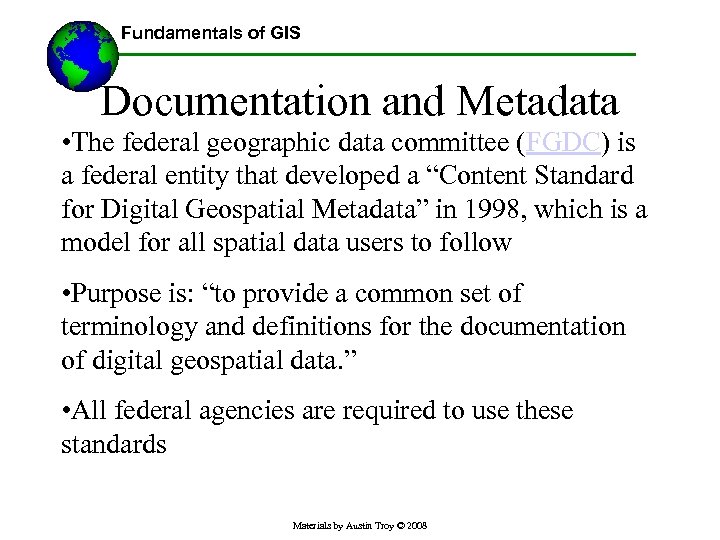 Fundamentals of GIS Documentation and Metadata • The federal geographic data committee (FGDC) is a federal entity that developed a “Content Standard for Digital Geospatial Metadata” in 1998, which is a model for all spatial data users to follow • Purpose is: “to provide a common set of terminology and definitions for the documentation of digital geospatial data. ” • All federal agencies are required to use these standards Materials by Austin Troy © 2008
Fundamentals of GIS Documentation and Metadata • The federal geographic data committee (FGDC) is a federal entity that developed a “Content Standard for Digital Geospatial Metadata” in 1998, which is a model for all spatial data users to follow • Purpose is: “to provide a common set of terminology and definitions for the documentation of digital geospatial data. ” • All federal agencies are required to use these standards Materials by Austin Troy © 2008
 Fundamentals of GIS Documentation and Metadata • Some roles of metadata 1. Information retrieval, cataloguing, querying and searching for data electronically. 2. Describing fitness for use and documenting the usability and quality of data. 3. Describing how to transfer, access or process data 4. Documenting all relevant characteristics of data needed to use it Materials by Austin Troy © 2008
Fundamentals of GIS Documentation and Metadata • Some roles of metadata 1. Information retrieval, cataloguing, querying and searching for data electronically. 2. Describing fitness for use and documenting the usability and quality of data. 3. Describing how to transfer, access or process data 4. Documenting all relevant characteristics of data needed to use it Materials by Austin Troy © 2008
 Fundamentals of GIS Documentation and Metadata • Critical components usually break down into: • Dataset identification, overview • Data quality • Spatial reference information • Data definition • Administrative information • Meta metadata Materials by Austin Troy © 2008
Fundamentals of GIS Documentation and Metadata • Critical components usually break down into: • Dataset identification, overview • Data quality • Spatial reference information • Data definition • Administrative information • Meta metadata Materials by Austin Troy © 2008
 Fundamentals of GIS Documentation and Metadata • Data identification, overview and administrative info: • General info: name and brief ID of dataset and owner organization, geographic domain, general description/ summary of content, data model used to represent spatial features, intent of production, language used , reference to more detailed documents, if applicable • Constraints on access and use • This is usually where info on currency is found Materials by Austin Troy © 2008
Fundamentals of GIS Documentation and Metadata • Data identification, overview and administrative info: • General info: name and brief ID of dataset and owner organization, geographic domain, general description/ summary of content, data model used to represent spatial features, intent of production, language used , reference to more detailed documents, if applicable • Constraints on access and use • This is usually where info on currency is found Materials by Austin Troy © 2008
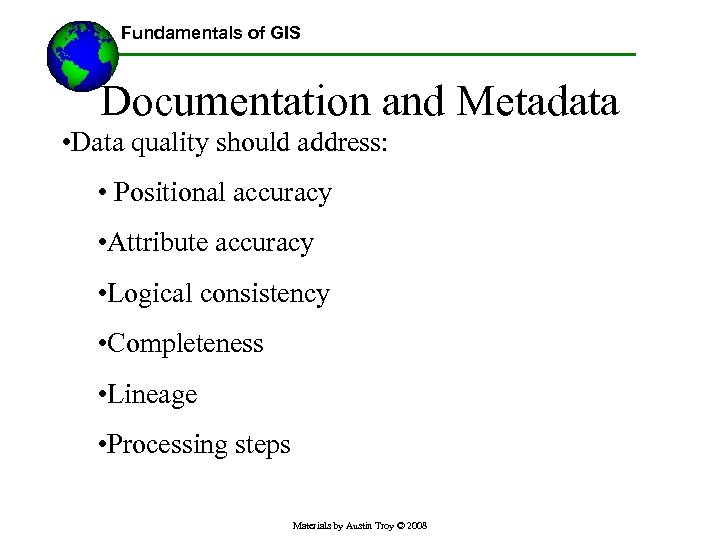 Fundamentals of GIS Documentation and Metadata • Data quality should address: • Positional accuracy • Attribute accuracy • Logical consistency • Completeness • Lineage • Processing steps Materials by Austin Troy © 2008
Fundamentals of GIS Documentation and Metadata • Data quality should address: • Positional accuracy • Attribute accuracy • Logical consistency • Completeness • Lineage • Processing steps Materials by Austin Troy © 2008
 Fundamentals of GIS Documentation and Metadata • Spatial reference should include: • horizontal coordinate system (e. g. State Plane) • Includes projection used, scale factors, longitude of central meridian, latitude of projection origin, distance units • Geodetic model (e. g. NAD 83), ellipsoid, semimajor axis Materials by Austin Troy © 2008
Fundamentals of GIS Documentation and Metadata • Spatial reference should include: • horizontal coordinate system (e. g. State Plane) • Includes projection used, scale factors, longitude of central meridian, latitude of projection origin, distance units • Geodetic model (e. g. NAD 83), ellipsoid, semimajor axis Materials by Austin Troy © 2008
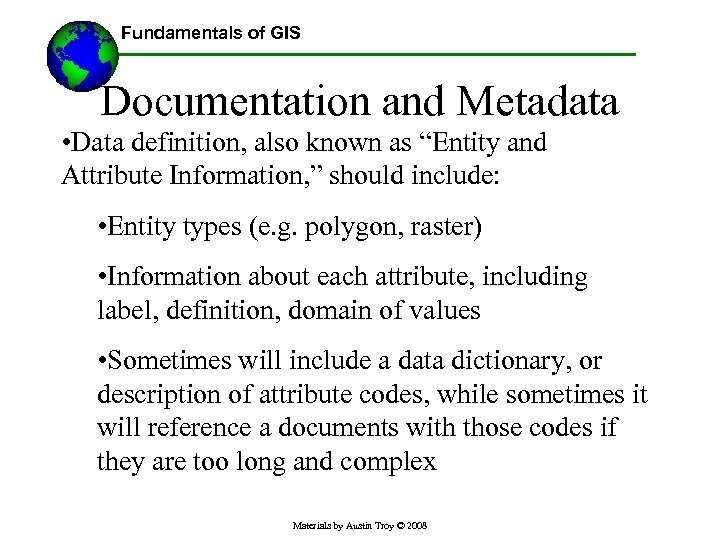 Fundamentals of GIS Documentation and Metadata • Data definition, also known as “Entity and Attribute Information, ” should include: • Entity types (e. g. polygon, raster) • Information about each attribute, including label, definition, domain of values • Sometimes will include a data dictionary, or description of attribute codes, while sometimes it will reference a documents with those codes if they are too long and complex Materials by Austin Troy © 2008
Fundamentals of GIS Documentation and Metadata • Data definition, also known as “Entity and Attribute Information, ” should include: • Entity types (e. g. polygon, raster) • Information about each attribute, including label, definition, domain of values • Sometimes will include a data dictionary, or description of attribute codes, while sometimes it will reference a documents with those codes if they are too long and complex Materials by Austin Troy © 2008
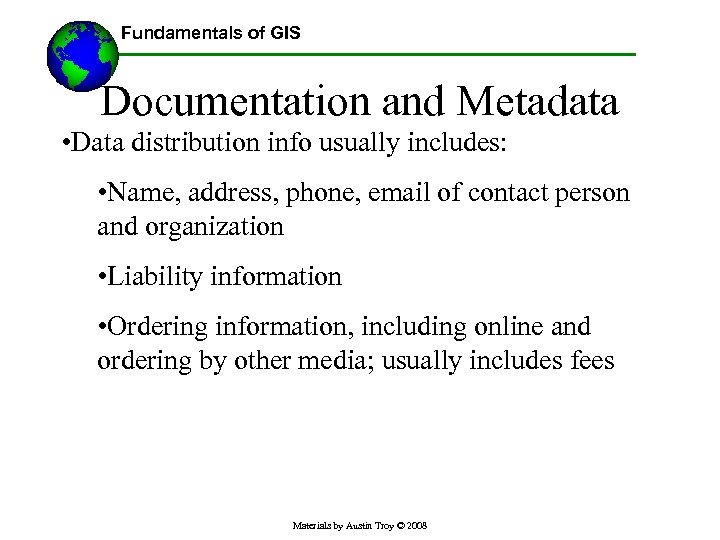 Fundamentals of GIS Documentation and Metadata • Data distribution info usually includes: • Name, address, phone, email of contact person and organization • Liability information • Ordering information, including online and ordering by other media; usually includes fees Materials by Austin Troy © 2008
Fundamentals of GIS Documentation and Metadata • Data distribution info usually includes: • Name, address, phone, email of contact person and organization • Liability information • Ordering information, including online and ordering by other media; usually includes fees Materials by Austin Troy © 2008
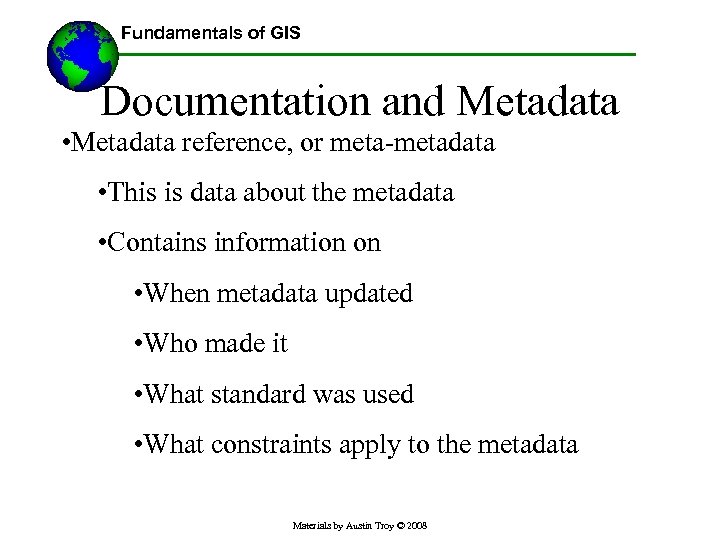 Fundamentals of GIS Documentation and Metadata • Metadata reference, or meta-metadata • This is data about the metadata • Contains information on • When metadata updated • Who made it • What standard was used • What constraints apply to the metadata Materials by Austin Troy © 2008
Fundamentals of GIS Documentation and Metadata • Metadata reference, or meta-metadata • This is data about the metadata • Contains information on • When metadata updated • Who made it • What standard was used • What constraints apply to the metadata Materials by Austin Troy © 2008
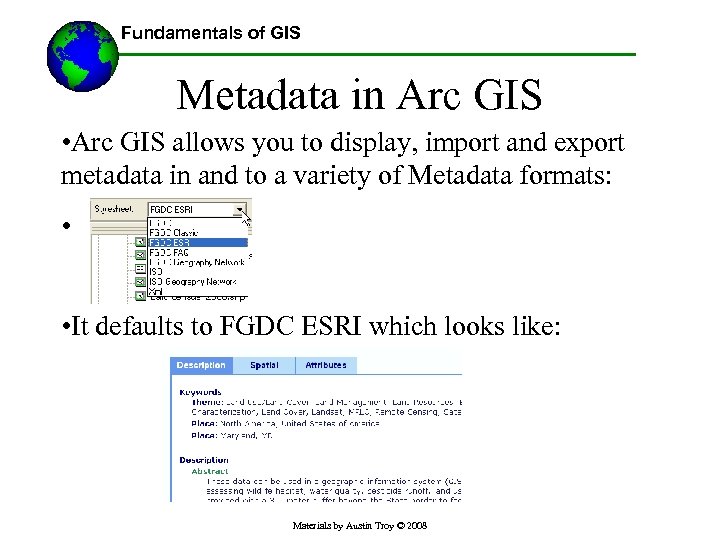 Fundamentals of GIS Metadata in Arc GIS • Arc GIS allows you to display, import and export metadata in and to a variety of Metadata formats: • • It defaults to FGDC ESRI which looks like: Materials by Austin Troy © 2008
Fundamentals of GIS Metadata in Arc GIS • Arc GIS allows you to display, import and export metadata in and to a variety of Metadata formats: • • It defaults to FGDC ESRI which looks like: Materials by Austin Troy © 2008
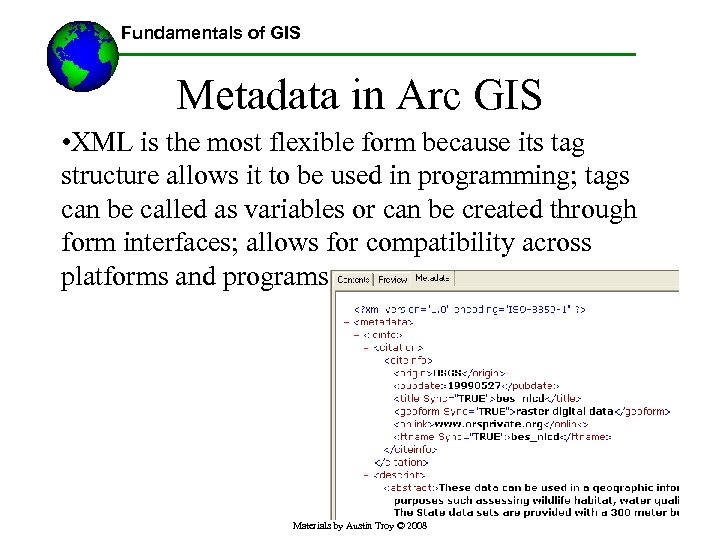 Fundamentals of GIS Metadata in Arc GIS • XML is the most flexible form because its tag structure allows it to be used in programming; tags can be called as variables or can be created through form interfaces; allows for compatibility across platforms and programs Materials by Austin Troy © 2008
Fundamentals of GIS Metadata in Arc GIS • XML is the most flexible form because its tag structure allows it to be used in programming; tags can be called as variables or can be created through form interfaces; allows for compatibility across platforms and programs Materials by Austin Troy © 2008
 Fundamentals of GIS Metadata in Arc GIS • In the past, complete metadata was only available as text; you had to create most embedded metadata tags yourself. Today many state and nationwide datasets come with complete embedded metadata including full attribute codes • E. g. NEDs, NLCD, all VCGI data Materials by Austin Troy © 2008
Fundamentals of GIS Metadata in Arc GIS • In the past, complete metadata was only available as text; you had to create most embedded metadata tags yourself. Today many state and nationwide datasets come with complete embedded metadata including full attribute codes • E. g. NEDs, NLCD, all VCGI data Materials by Austin Troy © 2008
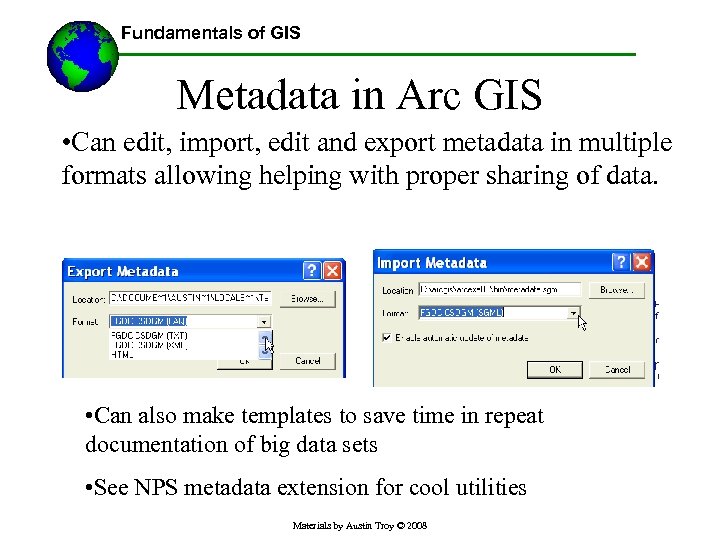 Fundamentals of GIS Metadata in Arc GIS • Can edit, import, edit and export metadata in multiple formats allowing helping with proper sharing of data. • Can also make templates to save time in repeat documentation of big data sets • See NPS metadata extension for cool utilities Materials by Austin Troy © 2008
Fundamentals of GIS Metadata in Arc GIS • Can edit, import, edit and export metadata in multiple formats allowing helping with proper sharing of data. • Can also make templates to save time in repeat documentation of big data sets • See NPS metadata extension for cool utilities Materials by Austin Troy © 2008


